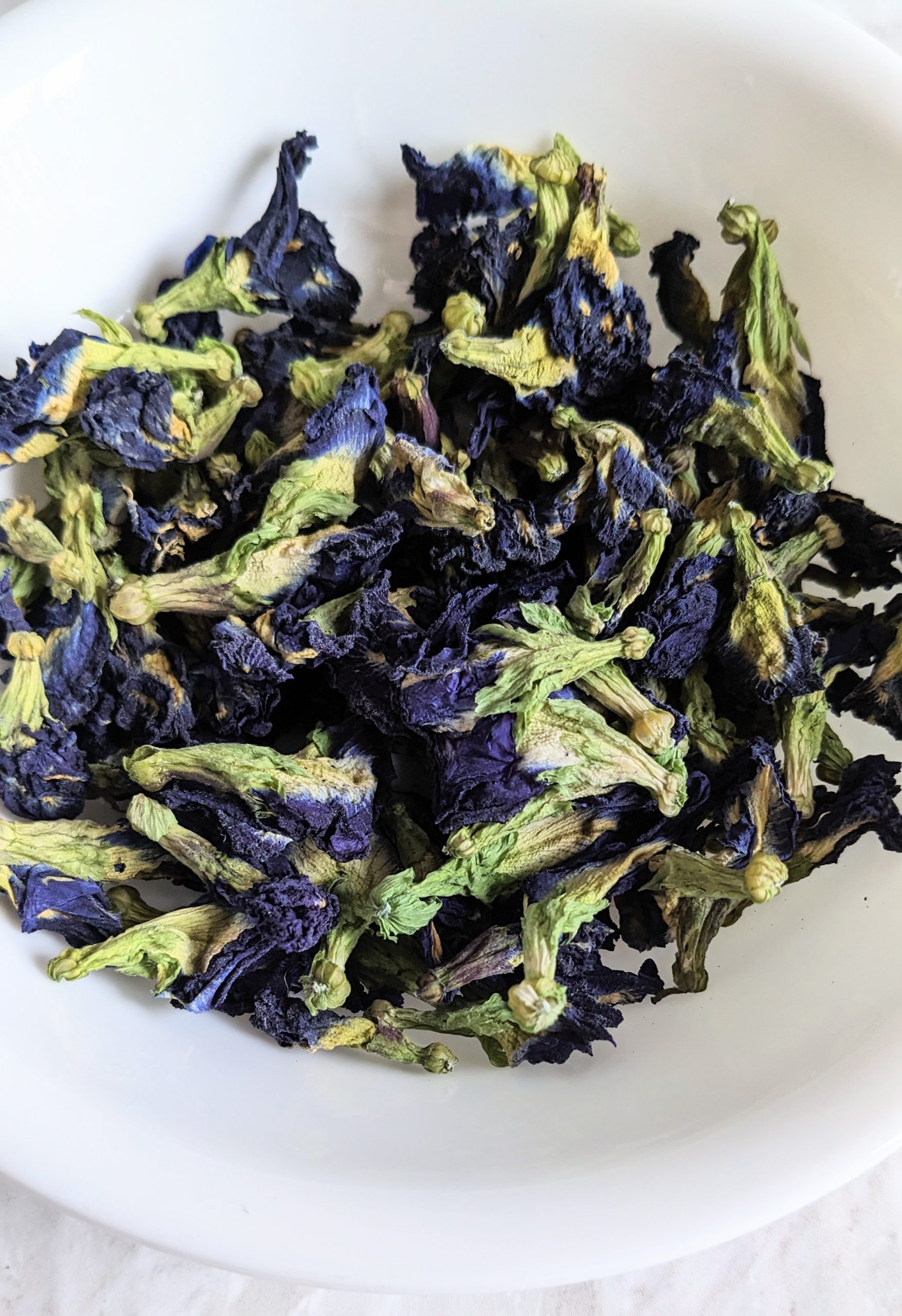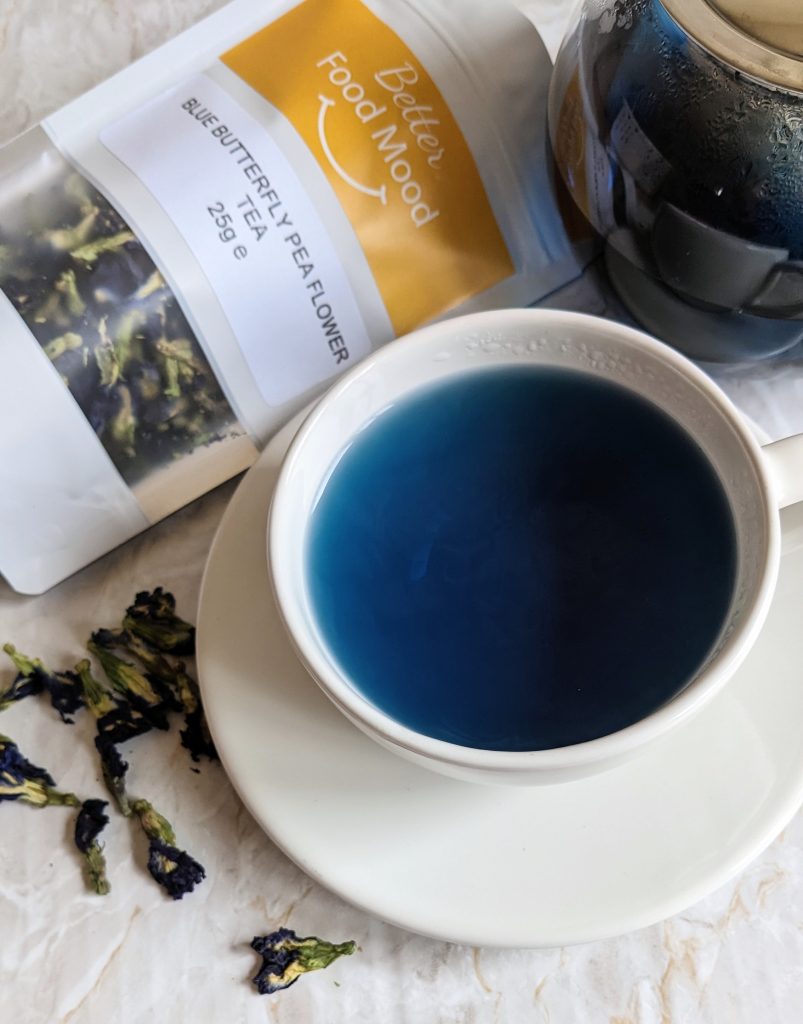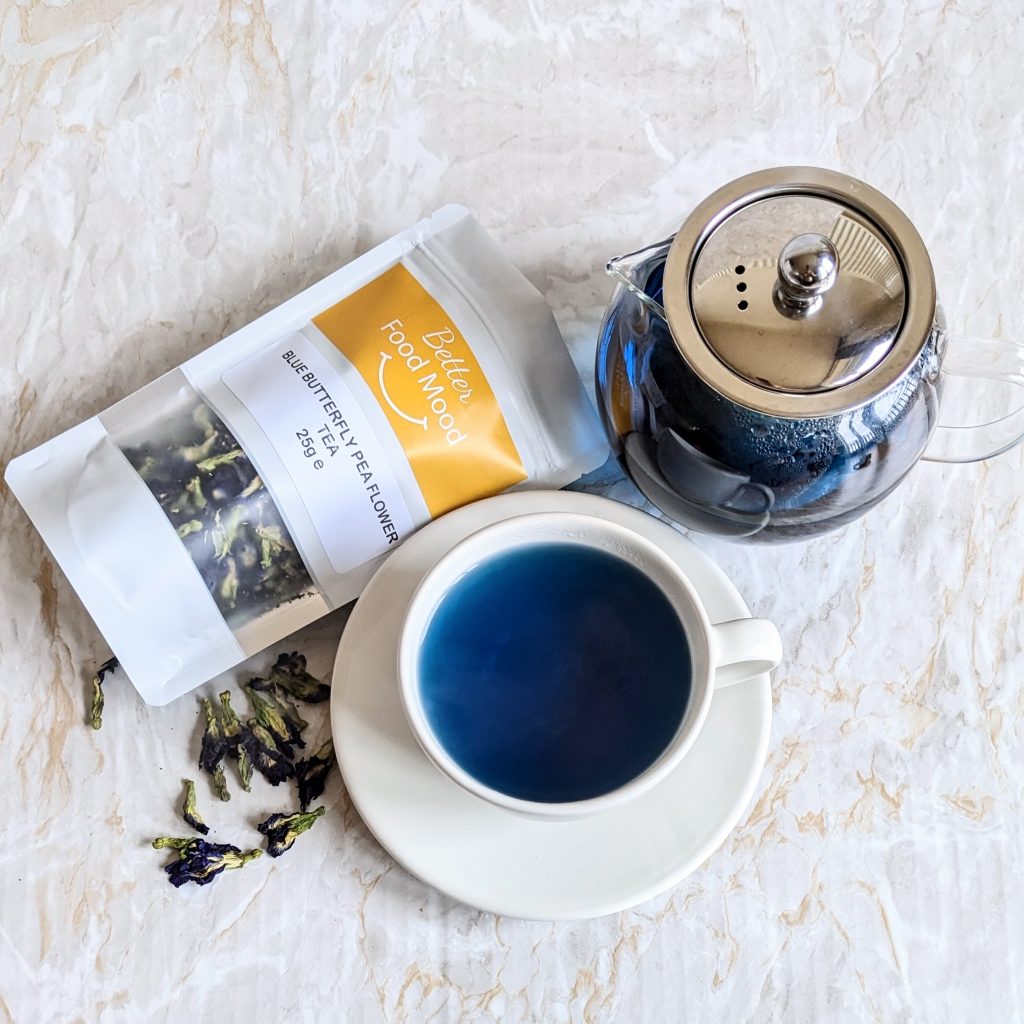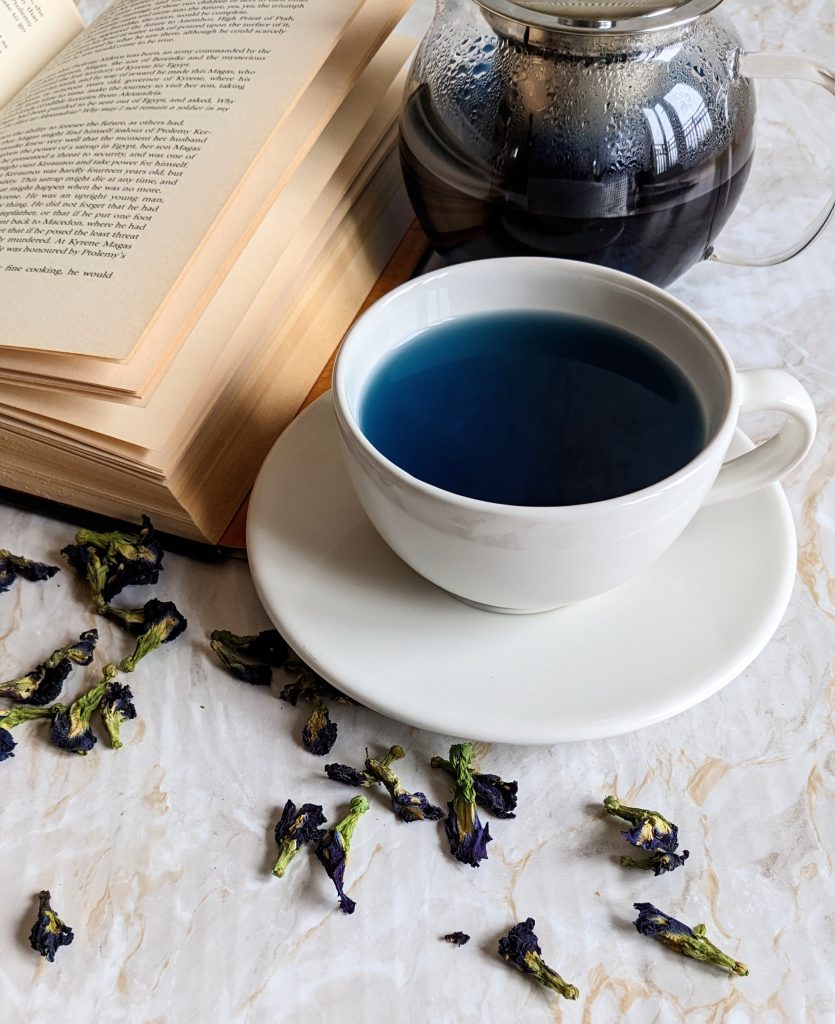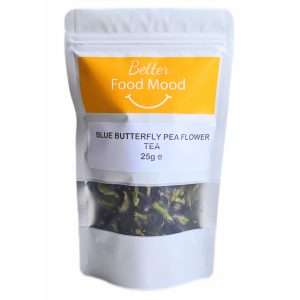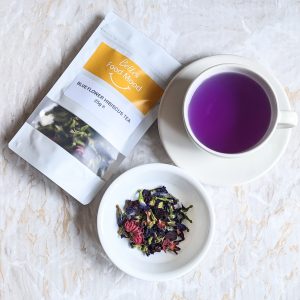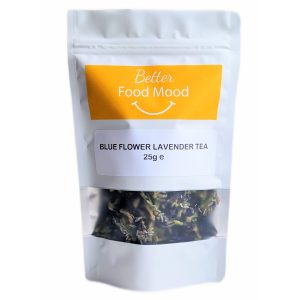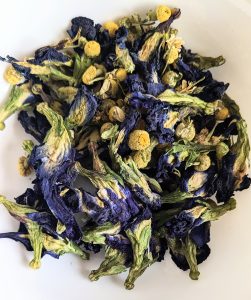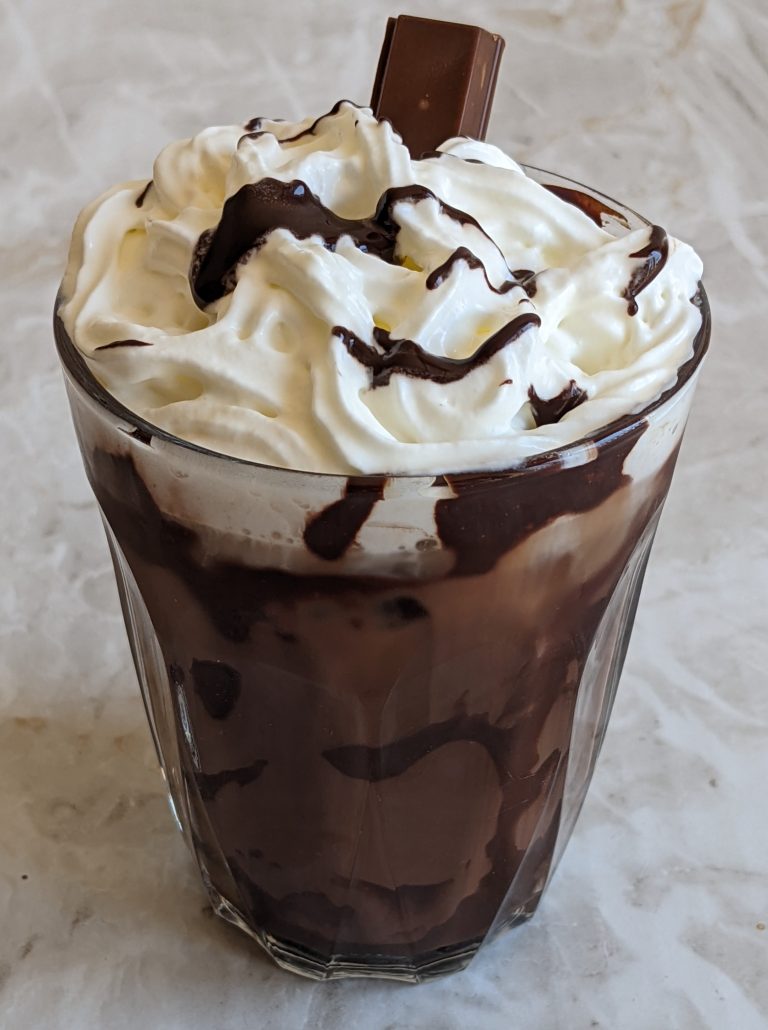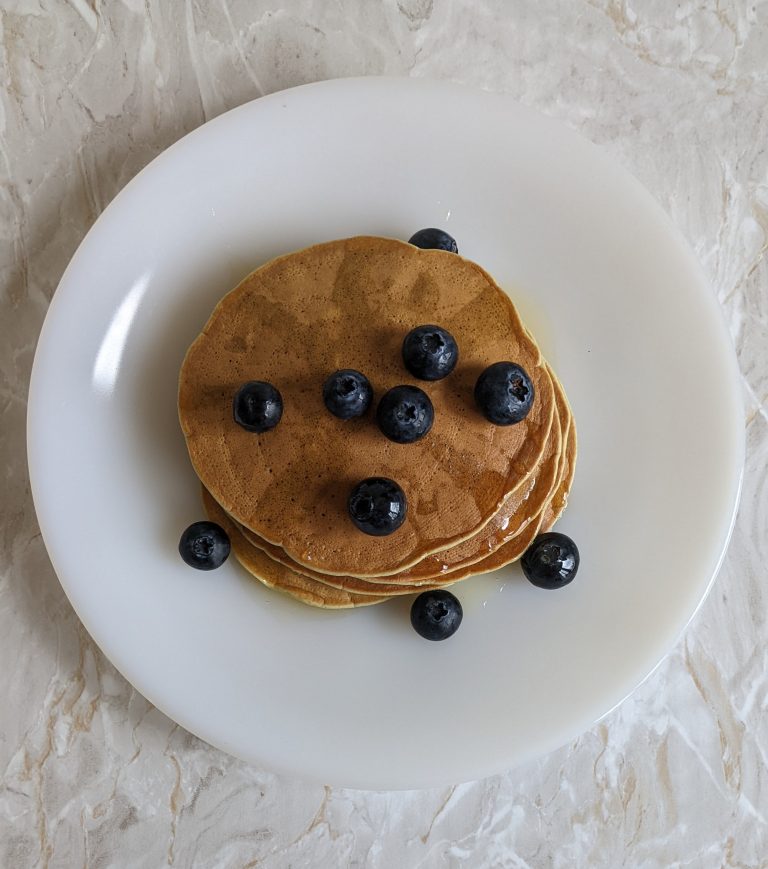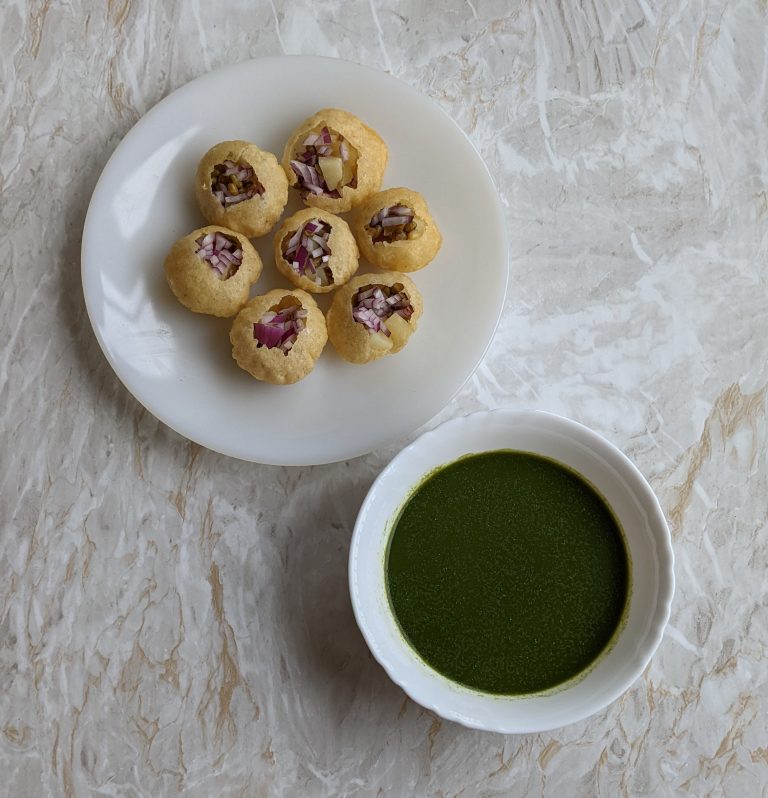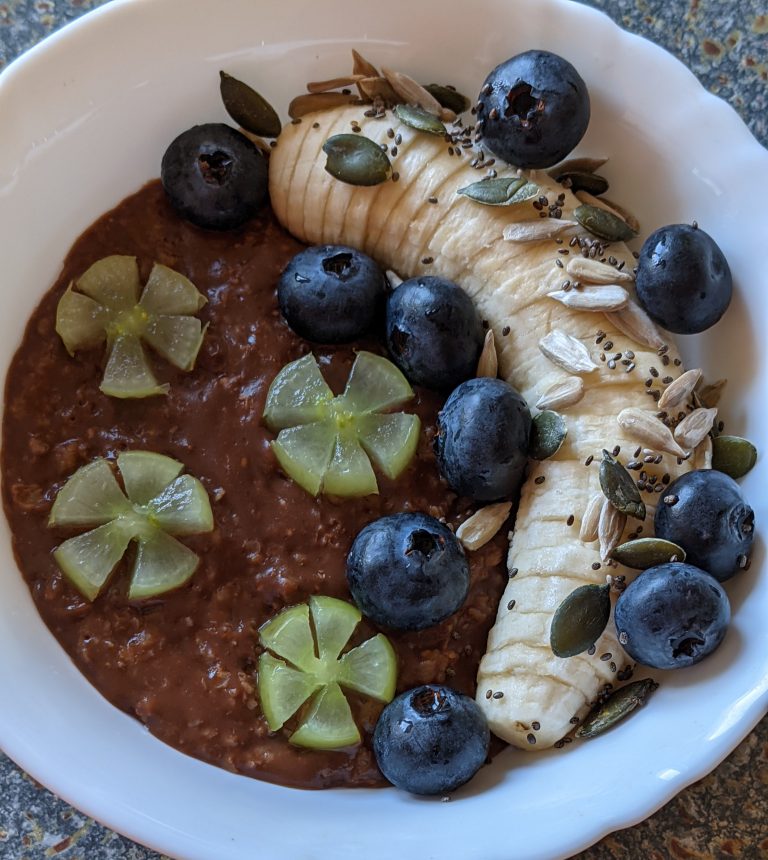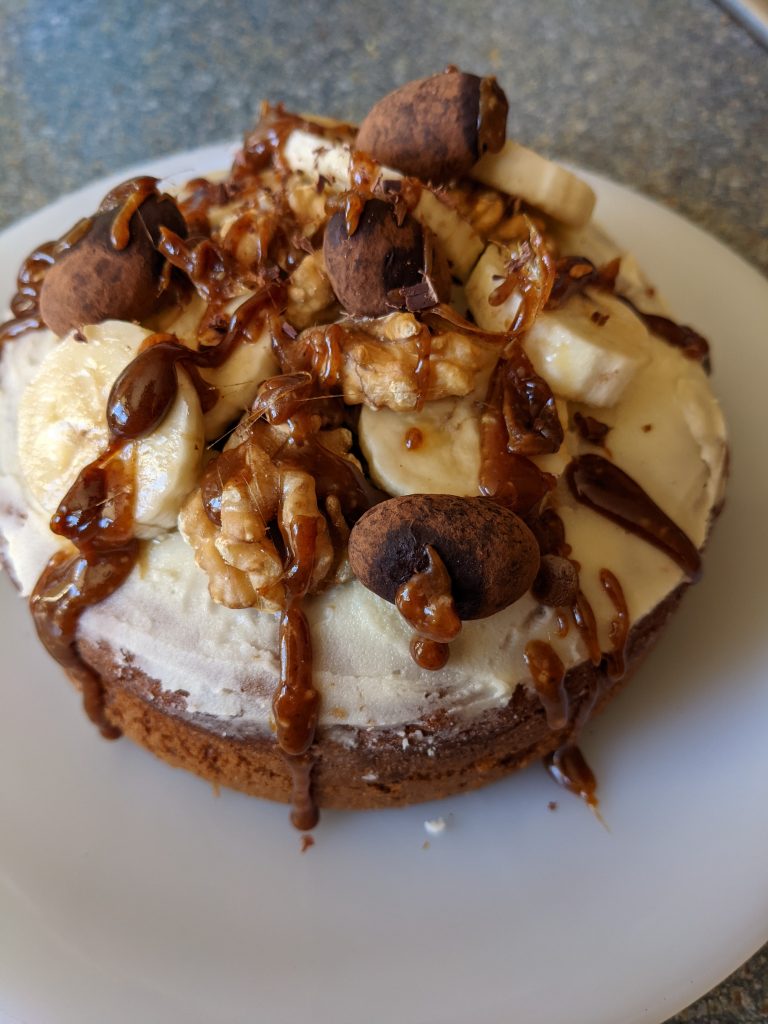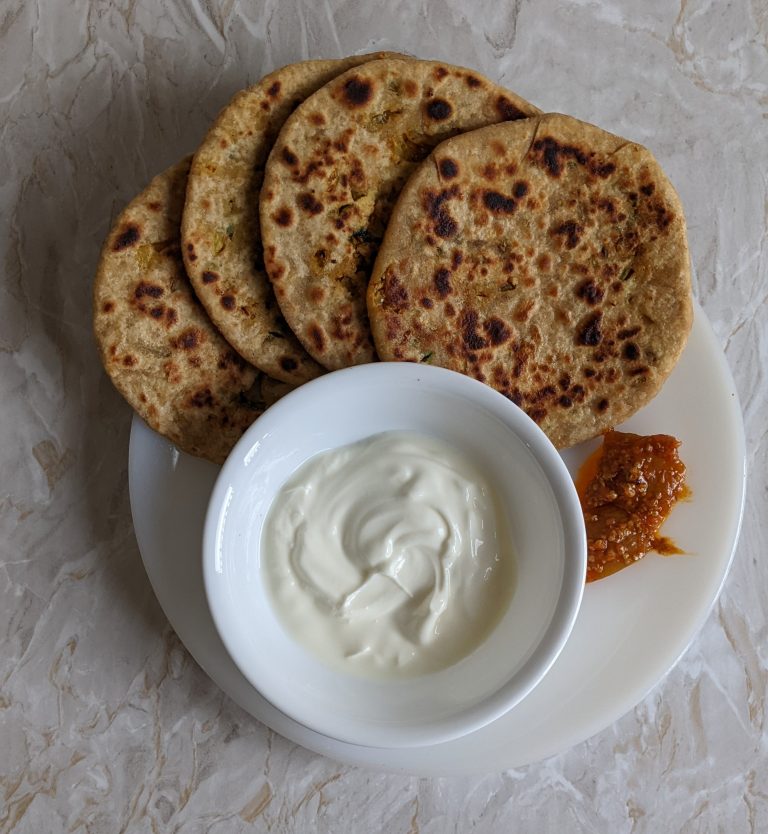What is Blue Butterfly Pea Tea good for?
What is blue butterfly pea tea made from?
Blue pea flower tea, also known as butterfly pea flower tea or Clitoria ternatea tea, is a caffeine-free herbal tea made from the flowers of the blue pea flower plant. The blue pea flower is native to Southeast Asia and is widely cultivated for its vibrant blue petals, which contain various bioactive compounds.
The tea has gained popularity in recent years due to its striking blue colour and potential health benefits. When brewed, the petals release a deep blue pigment that can transform the colour of the water. It’s often used in traditional cuisines, beverages, and herbal remedies in countries like Thailand, Malaysia, and Vietnam.
To prepare blue pea flower tea, dried or fresh blue flowers are steeped in hot water. The longer the steeping time, the stronger the blue colour becomes. The tea has a subtle earthy flavour with floral undertones, and it can be enjoyed hot or cold.
One of the main attractions of blue pea flower tea is its natural ability to change colour. When lemon juice or any acidic substance is added to the tea, it turns from blue to purple or even pink, creating a visually captivating drink. This unique characteristic has made it a popular ingredient in cocktails, mocktails, and other creative beverages.
Beyond its aesthetic appeal, blue pea flower tea is believed to offer several potential health benefits. It is rich in antioxidants, such as anthocyanins, which are known for their anti-inflammatory properties and potential positive effects on heart health. Additionally, blue pea flower tea is said to have calming properties and is sometimes used to alleviate stress and promote relaxation.
While research on blue pea flower tea’s health benefits is still ongoing, it is generally considered safe for consumption. However, pregnant or breastfeeding women and individuals with specific medical conditions should consult with their healthcare provider before incorporating it into their diet.
In summary, blue pea flower tea is a visually captivating herbal tea made from the petals of the blue pea flower plant. It offers a unique blue colour, changes colour with acidity, and is believed to possess antioxidants and potential health benefits.
What are the benefits of blue pea flower tea?
Blue pea flower tea is believed to offer several potential health benefits, although more research is needed to fully understand its effects. Here are some of the commonly attributed benefits of blue pea flower tea:
- Antioxidant properties: Blue pea flower tea is rich in antioxidants, including anthocyanins. These compounds help protect the body against damage caused by free radicals, potentially reducing the risk of chronic diseases.
- Anti-inflammatory effects: The presence of anthocyanins in blue pea flower tea may contribute to its anti-inflammatory properties. It may help reduce inflammation in the body, which is associated with various health conditions.
- Stress relief and relaxation: Blue pea flower tea is often consumed for its calming and stress-relieving properties. It is believed to have a soothing effect on the mind and body, promoting relaxation and potentially aiding in sleep quality.
- Cognitive health: Some research suggests that blue pea flower tea may have neuroprotective effects and could potentially support cognitive health. It may help improve memory and enhance brain function.
- Skin and hair health: The antioxidants present in blue pea flower tea may have benefits for the skin and hair. It is believed to promote healthy skin by combating oxidative stress and reducing signs of aging. It is also used in natural hair care to nourish and strengthen hair.
It’s important to note that while blue pea flower tea has been consumed for centuries in traditional medicine, scientific research on its specific health benefits is still limited. It should not be used as a substitute for professional medical advice or treatment. If you have any specific health concerns, it’s always advisable to consult with a healthcare professional.
How do I prepare blue tea from dried blue butterfly pea flowers?
Preparing blue pea flower tea is a simple process. Here’s a step-by-step guide on how to make it:
Ingredients:
- Dried or fresh blue pea flowers (approximately 1 tablespoon per cup of water)
- Water (filtered or mineral water is recommended)
- Optional: sweetener (such as honey or sugar), lemon juice (for colour change to purple)
Instructions:
- Bring water to a boil. The general ratio is 1 cup of water for every tablespoon of dried blue pea flowers. Adjust the quantities based on your desired serving size.
- Rinse the blue pea flowers under running water to remove any impurities. If using fresh flowers, skip this step.
- Place the blue pea flower flowers in a teapot or a heat-resistant container.
- Pour the boiling water over the flowers, ensuring they are fully submerged.
- Allow the flowers to steep in the hot water for about 5 to 10 minutes. You can adjust the steeping time based on your preference for colour intensity and flavour strength. The longer the steeping time, the stronger the blue colour becomes.
- After steeping, strain the tea to remove the flowers. You can use a fine-mesh strainer or a tea infuser.
- If desired, you can add a sweetener like honey or sugar to enhance the flavour. Stir until the sweetener dissolves. You can also add lemongrass to enhance the flavour too.
- For a colour-changing effect, add a few drops of lemon juice to the tea. The acidity of the lemon juice will cause the blue tea to change colour to purple or pink.
- Serve the blue pea flower tea hot or pour it over ice for a refreshing iced tea version.
- Enjoy your blue pea flower tea! Remember to experiment with steeping time and flavourings to find your preferred taste.
Note: You can also use blue pea flower tea as a base for various beverages like cocktails, mocktails, or herbal blends by adding other ingredients such as lemongrass, ginger, or mint leaves. Be creative and explore different combinations to suit your taste preferences.
Can dried blue butterfly pea flowers be used for anything else?
Dried blue butterfly pea flowers have various uses in culinary and beverage preparations, as well as in traditional medicine and natural skincare. Here are some common uses of dried blue butterfly pea flowers:
- Tea: Dried blue butterfly pea flowers are primarily used to make herbal tea. The flowers are steeped in hot water, resulting in a vibrant blue-coloured tea with a mild earthy flavour. It can be consumed as is or combined with other herbs, spices, or citrus fruits to enhance the taste and colour.
- Natural food colouring: The deep blue pigment of dried blue butterfly pea flowers can be used as a natural food colouring agent. It can be added to various dishes, baked goods, desserts, and beverages to impart a striking blue hue. When combined with acidic ingredients like lemon juice, the colour can transform into shades of purple or pink.
- Culinary applications: Dried blue butterfly pea flowers can be used as a culinary ingredient in various dishes. They are sometimes added to rice dishes, pastries, syrups, and sauces to add a unique colour and subtle floral flavour.
- Cocktails and mocktails: The vibrant blue colour of dried blue butterfly pea flowers makes them a popular ingredient in cocktails and mocktails. They can be used to create visually appealing drinks and provide a distinct flavour profile.
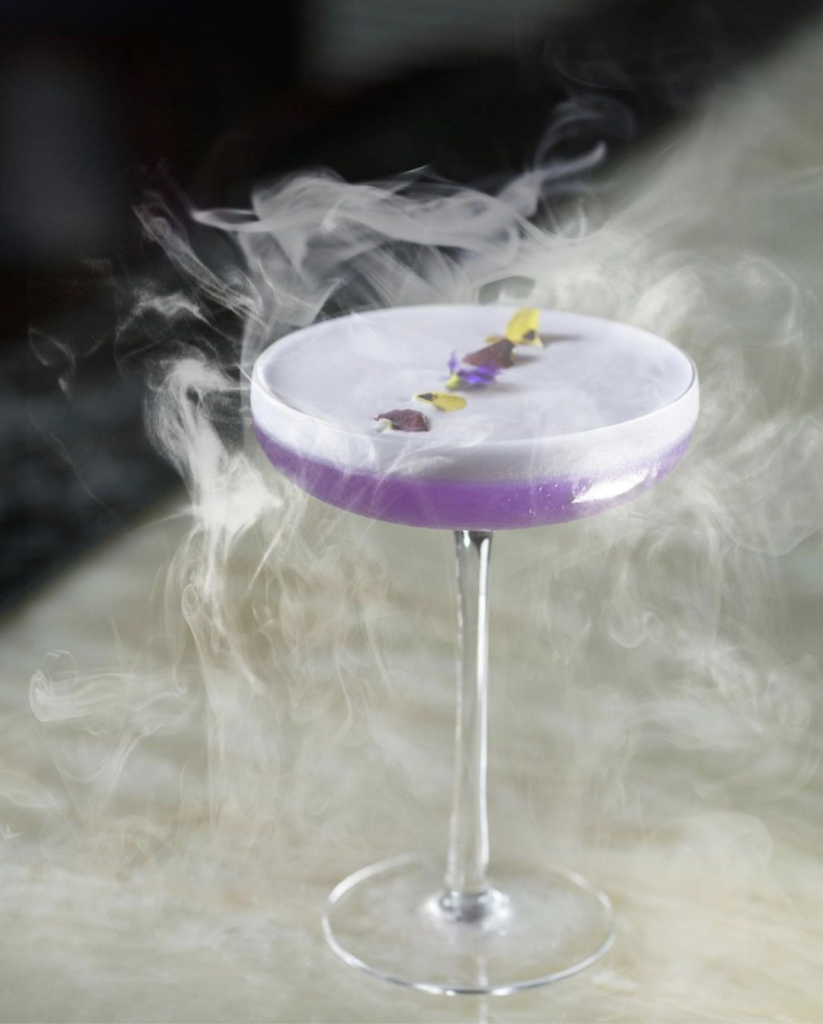
Purple cocktail created by Gong Bar in The Shard using our blue butterfly pea flowers - Natural dyeing: Dried blue butterfly pea flowers can be used as a natural dye for fabrics and textiles. They can produce shades of blue, purple, and grey, depending on the dyeing process and the mordants used.
- Traditional medicine: In traditional medicine practices, blue butterfly pea flowers have been used to make herbal remedies. They are believed to have various health benefits, including promoting digestive health, reducing inflammation, and boosting immunity. However, it’s important to note that scientific evidence supporting these claims is limited.
- Skincare and haircare: Blue butterfly pea flowers are sometimes used in natural skincare and haircare products. The flowers’ antioxidant properties and potential anti-inflammatory effects are believed to be beneficial for the skin and hair. They can be used to make infusions, facial masks, hair rinses, or incorporated into cosmetic formulations.
When using dried blue butterfly pea flowers, it’s important to source them from reliable and reputable sources to ensure their quality and purity.
The blue pea flower blends we have in our store
Classic blue pea flowers tea
Our classic blue pea flower tea is a pure blue pea flower tea with only dried blue pea flowers. It is perfect for blue pea flower tea or to use in other food and beverage as a natural colouring agent or for topical skin or hair care.
Our blue pea flowers are of premium quality with no additives or artificial colours. Our premium tea comes from Thailand. Be careful when buying blue pea flowers, especially from China, as artificial colours may be added.
Our blue pea flower tea is vegan and gluten-free. Add lemon if you’d like to change it to a purple colour!
Purple Butterfly Pea Flowers and Hibiscus Flowers tea
I created this purple butterfly pea flower and hibiscus flowers tea blend for those who do not want to add lemon to create a tangy flavour.
This purple butterfly pea flower and hibiscus flower tea is naturally a purple tea when you prepare it without the need to add any lemon.
Hibiscus is thought to be rich in anti-oxidants too and is thought to improve skin. Hibiscus, in addition to blue butterfly pea flowers creates a tea that is super rich in antioxidants that is perfect for delaying premature aging.
Blue Butterfly Pea Flowers and Lavender Buds tea
I created this blue butterfly pea flower and lavender buds tea blend to create a more palatable tea.
Pure blue butterfly pea flower tea has a herb like taste which may or may not be the best taste. Adding lavender buds gives this tea a lovely camphor like taste and will help you feel relaxed.
Lavender buds are thought to traditionally aid with sleep and calm the senses. This blue pea flowers and lavender buds tea is a great way to relax whilst providing your body with that wonderful dose of antioxidants. I call it the Beauty Sleep Tea 🙂
Blue Butterfly Pea Flowers, Rose Petals and Lavender Buds tea
This blue butterfly pea flowers, rose petals and lavender buds tea blend creates an extra calming blue tea blend. I also think it is visually very appealing to the senses and creates a full relaxing experience from preparing the tea to consuming it.
Rose petals and lavender buds both calm the senses and this blue tea blend is perfect for bed time or when you need to relax e.g. when you are meditating.
Blue Butterfly Pea Flowers and Chamomile Flowers tea
This blue butterfly pea flowers and chamomile flower tea blend is another relaxing and calming tea blend.
Instead of lavender and rose, I used chamomile because I quite like the scent and taste of chamomile.
This is another optional blend for when you need to relax in a fun way!
What are the benefits of anthocyanins found in blue pea flower tea?
Anthocyanins, the natural pigments found in blue pea flower tea, offer a range of potential health benefits. These compounds belong to the flavonoid family and are known for their antioxidant and anti-inflammatory properties. Here are some of the benefits associated with anthocyanins:
- Antioxidant activity: Anthocyanins are powerful antioxidants that help protect cells from damage caused by free radicals. They neutralize harmful molecules, reducing oxidative stress and potentially lowering the risk of chronic diseases such as heart disease, cancer, and neurodegenerative disorders.
- Anti-inflammatory effects: Anthocyanins have been found to possess anti-inflammatory properties. They can help reduce inflammation in the body, which is associated with various conditions, including arthritis, cardiovascular diseases, and inflammatory bowel disease.
- Cardiovascular health: Anthocyanins may contribute to cardiovascular health by promoting healthy blood vessels and improving blood flow. They have been linked to lowering blood pressure, reducing LDL (“bad”) cholesterol levels, and improving endothelial function, which supports heart health.
- Cognitive function: Research suggests that anthocyanins may have beneficial effects on cognitive function and brain health. They may help improve memory, cognition, and overall brain performance. Additionally, anthocyanin-rich foods have been associated with a reduced risk of age-related cognitive decline and neurodegenerative diseases such as Alzheimer’s and Parkinson’s.
- Eye health: Anthocyanins may support eye health by protecting against oxidative damage and reducing the risk of age-related macular degeneration (AMD), cataracts, and other vision-related disorders. They have been shown to have a positive impact on retinal health and visual function.
- Diabetes management: Anthocyanins may have a role in diabetes management. They can help regulate blood sugar levels, improve insulin sensitivity, and reduce the risk of complications associated with diabetes.
It’s important to note that while anthocyanins show promise in promoting health, more research is needed to fully understand their mechanisms and benefits. Blue pea flower tea is a source of anthocyanins, but its specific effects on health can vary depending on factors such as preparation, consumption frequency, and individual variations. As always, it’s recommended to maintain a balanced diet, incorporating a variety of fruits, vegetables, and other foods rich in flavonoids to obtain the benefits of these compounds.
What are the benefits of blue butterfly pea flowers in skin care?
Blue butterfly pea flowers have gained popularity in skincare due to their potential benefits for the skin. While scientific research on their specific effects is limited, here are some potential benefits associated with blue butterfly pea flowers in skincare:
- Antioxidant properties: Blue butterfly pea flowers contain anthocyanins, which are known for their antioxidant activity. Antioxidants help protect the skin from free radicals, which can cause oxidative damage and premature aging. The flowers’ antioxidant properties may help promote a more youthful and radiant complexion.
- Anti-inflammatory effects: Blue butterfly pea flowers may possess anti-inflammatory properties. Inflammation is a common factor in skin conditions such as acne, eczema, and psoriasis. Using skincare products containing blue butterfly pea flowers may help soothe and calm the skin, reducing redness and inflammation.
- Hydration and moisturization: Blue butterfly pea flowers are believed to have hydrating properties, helping to improve skin moisture levels. They can assist in maintaining the skin’s natural hydration barrier, resulting in smoother and more supple skin.
- Collagen support: The anthocyanins found in blue butterfly pea flowers may promote collagen production in the skin. Collagen is a protein that helps maintain skin elasticity and firmness. By supporting collagen synthesis, blue butterfly pea flowers may contribute to a more youthful appearance and reduce the appearance of fine lines and wrinkles.
- Brightening and complexion-enhancing: Blue butterfly pea flowers are known for their vibrant blue color. When used in skincare products, they can provide a temporary brightening effect, helping to even out the skin tone and impart a natural glow. However, it’s important to note that the color change is temporary and not a long-term skin lightening solution.
It’s worth mentioning that individual results may vary, and more scientific research is needed to fully understand the specific benefits of blue butterfly pea flowers in skincare. When incorporating blue butterfly pea flower-based skincare products into your routine, it’s advisable to patch test and observe how your skin responds. Additionally, it’s important to choose reputable skincare brands and consult with a dermatologist or skincare professional for personalized advice and recommendations.
How can I use blue butterfly pea flowers in my skin care routine?
Blue butterfly pea flowers can be incorporated into your skincare routine in various ways. Here are a few suggestions on how to use them:
- Infused water or hydrosol: Prepare a gentle infused water or hydrosol by steeping dried blue butterfly pea flowers in boiling water. Allow it to cool, strain out the flowers, and transfer the infused water into a spray bottle. Use it as a facial mist or toner to refresh and hydrate your skin throughout the day.
- Face mask: Create a soothing and brightening face mask by combining powdered blue butterfly pea flowers with ingredients like yogurt, honey, or aloe vera gel. Mix them well to form a smooth paste and apply it to your face. Leave the mask on for about 15-20 minutes before rinsing it off with warm water. This can help promote hydration, reduce inflammation, and improve skin tone.
- Herbal steam: Add dried blue butterfly pea flowers to a bowl of hot water and create a steam tent for your face. Lean over the bowl and cover your head with a towel to trap the steam. Enjoy the gentle steam for a few minutes, allowing the botanical properties of the flowers to open up your pores, promote circulation, and enhance absorption of other skincare products.
- Bath soak: Place a handful of dried blue butterfly pea flowers in a muslin bag or infuser and toss it into your warm bathwater. The flowers will release their colour and potential skin benefits into the water, creating a soothing and aromatic bath. Relax and soak in the infused water to hydrate and nourish your skin.
- DIY skincare formulations: You can incorporate powdered blue butterfly pea flowers into your DIY skincare formulations, such as face scrubs, masks, or serums. Mix them with other natural ingredients based on your skin’s needs to create customized skincare products.
Remember to perform a patch test before using any new skincare ingredient, including blue butterfly pea flowers, to check for any allergic reactions or skin sensitivities. It’s also important to source high-quality dried flowers from reputable suppliers to ensure their purity and effectiveness in your skincare routine.
What are the benefits of blue butterfly pea flowers in hair care?
Blue butterfly pea flowers offer potential benefits when incorporated into hair care routines. While scientific research on their specific effects is limited, here are some potential benefits associated with blue butterfly pea flowers in hair care:
- Nourishing and conditioning: Blue butterfly pea flowers are believed to have nourishing properties that can help condition the hair. They may provide hydration, promote softness, and improve the overall texture of the hair.
- Hair growth promotion: The antioxidant properties of blue butterfly pea flowers may contribute to a healthy scalp environment, which is essential for promoting hair growth. A healthy scalp can help support the growth of strong and lustrous hair.
- Scalp health: Blue butterfly pea flowers may have soothing and anti-inflammatory effects on the scalp. They could help alleviate scalp irritation, dryness, and itchiness, promoting a healthier scalp.
- Natural hair colouring: Blue butterfly pea flowers can be used as a natural hair dye or colour enhancer. When steeped in hot water and used as a rinse, they can impart a temporary blue hue to light-coloured or bleached hair. However, the colour change is temporary and will gradually fade with washes.
- Shine enhancement: Blue butterfly pea flowers are believed to help enhance the natural shine of the hair, making it appear lustrous and healthy.
- Hair detangling: Blue butterfly pea flower-infused hair rinses or conditioners may help smoothen the hair cuticles, making it easier to detangle and manage the hair.
How do I incorporate blue butterfly pea flowers in my hair care routine?
Prepare a hair rinse by steeping dried blue butterfly pea flowers in hot water, allowing it to cool, and using it as a final rinse after shampooing and conditioning your hair.
- Mix powdered blue butterfly pea flowers with other natural ingredients like yogurt, aloe vera gel, or coconut milk to create a nourishing hair mask. Apply the mask to your hair, leave it on for a specific period as directed, and rinse thoroughly.
- Look for hair care products that contain blue butterfly pea flower extracts or infusions.
Remember that individual results may vary, and it’s important to perform a patch test before using any new hair care ingredient to check for any allergic reactions or sensitivities. Additionally, it’s recommended to choose reputable hair care brands or consult with a hairstylist or trichologist for personalized advice and recommendations.
How does blue butterfly pea tea turn purple?
To change your blue butterfly tea from blue into purple, simply add lemon. You can vary the shade of blue or purple by adjusting the amount of lemon juice you add!
Here are the more technical details for the inquisitive ones 🙂
Blue butterfly pea tea, derived from the blue pea flower (Clitoria ternatea), undergoes a colour transformation from blue to purple when exposed to acidic substances. This colour change is due to the natural pigments present in the petals of the flower, particularly anthocyanins.
Anthocyanins are water-soluble pigments that are responsible for the vibrant blue colour of the tea. However, they are sensitive to changes in pH levels. When an acidic substance, such as lemon juice or any other citrus juice, is added to the tea, it alters the pH, causing the blue colour to shift towards a more acidic colour spectrum.
The change occurs because the anthocyanin pigments in the blue pea flower are pH-dependent. In an acidic environment, the pigments undergo a chemical reaction called a structural change. This changes their shape and alters their absorption of light, resulting in a shift in colour from blue to purple or even pink.
The acidity of the added substance disrupts the pigment’s molecular structure, leading to a change in the wavelengths of light absorbed and reflected. As a result, the tea transitions from blue to purple, creating a visually captivating transformation.
It’s worth noting that the extent of the colour change may vary depending on factors such as the concentration of the acidic substance, the pH level, and the duration of exposure. Additionally, different acidic substances may yield slightly different shades of purple.
Can we drink blue pea flower tea daily?
Blue pea flower tea is generally considered safe for regular consumption. Drinking it daily in moderation is unlikely to pose any significant health risks for most people. However, it’s important to note that individual tolerance and sensitivities can vary.
Here are a few considerations regarding daily consumption of blue pea flower tea:
- Moderation: As with any herbal tea, it is advisable to consume blue pea flower tea in moderation. One to three cups per day is typically considered a reasonable amount. Drinking excessive amounts may have unintended effects or interact with certain medications.
- Allergies and sensitivities: Some individuals may be allergic or have sensitivities to blue pea flower or related plants. If you have a known allergy or experience any adverse reactions after consuming blue pea flower tea, discontinue use and consult a healthcare professional.
- Pregnancy and breastfeeding: Limited information is available regarding the safety of blue pea flower tea during pregnancy and breastfeeding. It’s always best to consult with a healthcare provider before including it in your diet during these periods.
- Interactions with medications: Blue pea flower tea is generally considered safe, but it’s important to be cautious if you are taking any medications. If you have concerns about potential interactions, consult your healthcare provider or a pharmacist to ensure it won’t interfere with any medications you are currently taking.
- Personal health considerations: If you have specific health conditions or concerns, it’s advisable to consult with a healthcare professional before consuming blue pea flower tea regularly. They can provide personalized advice based on your individual circumstances.
Remember that while blue pea flower tea has some potential health benefits, its effects may vary among individuals. It’s always a good idea to listen to your body and make informed decisions based on your own health and well-being.
Who should not drink butterfly pea tea?
While butterfly pea tea (blue pea flower tea) is generally safe for consumption, there are a few groups of people who should exercise caution or avoid it. Here are some considerations:
- Allergies and Sensitivities: Individuals who have known allergies or sensitivities to the blue pea flower plant or related plants should avoid consuming butterfly pea tea. If you experience any allergic reactions, such as itching, swelling, or difficulty breathing, discontinue use and seek medical attention.
- Pregnancy and Breastfeeding: Limited information is available on the safety of butterfly pea tea during pregnancy and breastfeeding. It is advisable to consult with a healthcare professional before consuming it during these periods to ensure it is safe for you and your baby.
- Medications and Medical Conditions: If you have any underlying medical conditions or are taking specific medications, it’s important to consult with your healthcare provider before incorporating butterfly pea tea into your diet. Certain compounds in the tea may interact with medications or exacerbate certain conditions. This is especially important if you have blood pressure issues, kidney problems, or are taking medications that affect blood clotting.
- Iron Absorption: Butterfly pea tea contains tannins, which may inhibit the absorption of iron from plant-based sources. If you have iron deficiency or rely heavily on plant-based iron sources, it is advisable to consume butterfly pea tea in moderation and not with iron-rich meals to avoid any potential interference with iron absorption.
- Surgery: Due to its potential effects on blood clotting and blood pressure, it is recommended to discontinue the consumption of butterfly pea tea at least two weeks before scheduled surgery to avoid any unwanted interactions or complications.
As with any dietary change or herbal product, it is best to consult with a healthcare professional or a registered dietitian to determine if butterfly pea tea is suitable for your specific health circumstances. They can provide personalized advice based on your medical history, current medications, and individual needs.
Does butterfly pea tea strain your teeth?
Butterfly pea tea, also known as blue pea flower tea, can potentially cause staining on teeth due to its vibrant blue color. The deep blue pigment in the tea may have the ability to adhere to the tooth enamel and cause temporary discoloration. However, the extent of staining can vary from person to person, depending on factors such as oral hygiene, frequency of consumption, and individual tooth characteristics.
To minimize the risk of tooth staining from butterfly pea tea, you can consider the following tips:
- Practice good oral hygiene: Brushing your teeth regularly, particularly after consuming pigmented foods or beverages, can help prevent staining. Use a soft-bristled toothbrush and a fluoride toothpaste to gently brush your teeth.
- Rinse your mouth: After drinking butterfly pea tea, rinse your mouth with water to help remove any residue and reduce the chance of staining.
- Use a straw: Drinking butterfly pea tea through a straw can help minimize contact between the tea and your teeth, potentially reducing the risk of staining.
- Limit consumption or alternate with other beverages: If you’re concerned about tooth staining, you can reduce the frequency of consuming butterfly pea tea or alternate it with other beverages that are less likely to cause staining.
- Professional dental care: Regular visits to your dentist for professional cleanings can help remove surface stains and maintain the overall health of your teeth.
It’s important to note that tooth staining from butterfly pea tea is usually temporary and can be addressed through proper oral hygiene practices. If you’re particularly concerned about tooth discoloration, you may consider consulting with a dental professional for personalized advice and treatment options.
What are the side effects of blue tea?
Blue tea, also known as blue pea flower tea or butterfly pea flower tea, is generally considered safe for consumption, and side effects are rare. However, it’s important to be aware of potential reactions and consider individual sensitivities. Here are a few things to keep in mind:
- Allergic reactions: Some individuals may be allergic to blue pea flower or related plants. If you have known allergies to flowers or legumes, it’s possible to experience allergic reactions such as itching, rash, swelling, or difficulty breathing. Discontinue use if any allergic symptoms occur and seek medical attention.
- Gastrointestinal discomfort: In rare cases, some individuals may experience gastrointestinal discomfort, such as stomach upset, bloating, or diarrhea, after consuming blue tea. If you have a sensitive digestive system, it’s advisable to start with a small amount and monitor your body’s response.
- Blood pressure and blood clotting: Blue pea flower tea may have potential effects on blood pressure and blood clotting. If you have low blood pressure, are on anticoagulant medications, or have clotting disorders, it’s recommended to consult with your healthcare provider before consuming blue tea regularly.
- Iron absorption: Blue pea flower tea contains tannins, which can inhibit the absorption of iron from plant-based sources. If you have iron deficiency or rely heavily on plant-based iron sources, it’s advisable to consume blue tea in moderation and not with iron-rich meals to avoid any potential interference with iron absorption.
- Pregnancy and breastfeeding: While blue pea flower tea is generally considered safe, pregnant or breastfeeding women should exercise caution. Limited information is available on its safety during these periods, so it’s best to consult with a healthcare professional before consuming it.
It’s important to note that individual reactions can vary, and what may be well-tolerated by most people may cause discomfort or adverse effects in some individuals. If you have any concerns or pre-existing health conditions, it’s always advisable to consult with a healthcare professional before incorporating blue tea into your diet.
Is butterfly pea safe for kids?
Butterfly pea tea (blue pea flower tea) is generally considered safe for children when consumed in moderation. However, it’s important to consider a few factors before offering it to children:
- Age appropriateness: While there is no specific age restriction for butterfly pea tea, it is typically recommended for children who are old enough to consume herbal teas. Younger children, especially infants and toddlers, should avoid consuming tea and stick to breast milk, formula, or age-appropriate beverages.
- Allergies and sensitivities: Some children may have allergies or sensitivities to the blue pea flower or related plants. If your child has a known allergy or experiences any adverse reactions after consuming butterfly pea tea, discontinue use and seek medical attention.
- Caffeine content: Butterfly pea tea is naturally caffeine-free, which makes it a suitable alternative to caffeinated beverages for children. However, if the tea is blended with other ingredients or combined with additional additives, it’s essential to check for caffeine content or other potential allergens.
- Color-changing effect: Children may be fascinated by the color-changing properties of butterfly pea tea. It’s important to supervise them and ensure they do not consume excessive amounts or play with the tea for extended periods, as excessive exposure to pigments may lead to temporary staining of teeth or skin.
- Moderation: As with any herbal tea, it’s important to encourage moderate consumption. Offering butterfly pea tea as an occasional treat or in controlled amounts is recommended.
As every child is different, it’s always a good idea to consult with a pediatrician or healthcare professional before introducing butterfly pea tea into your child’s diet. They can provide guidance based on your child’s individual health, dietary needs, and any specific concerns you may have.

